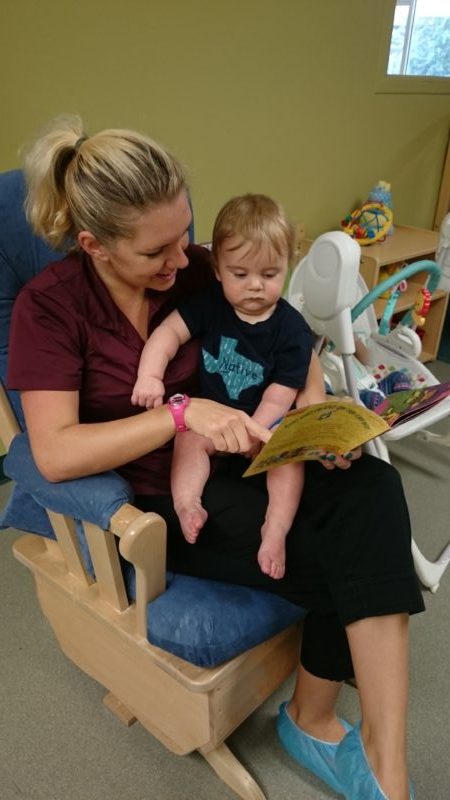Reading Readiness at Stepping Stone School
Research demonstrates that the single activity that has the greatest impact on reading readiness is being read to on a regular basis. Each day, the children at Stepping Stone School listen to read-alouds, observe environmental print, delve into the classroom library, interact with our classic children’s literature collection, and explore other books and printed material. These activities benefit children of all ages and support numerous pre-reading skills.
Daily Reading
As Stepping Stone teachers read to the children in their classrooms, they employ a number of strategies and activities that teach necessary preparedness skills:
Before reading a book, teachers will often talk about the parts of the book like the cover and the title page. Teachers may also discuss the roles of the author and the illustrator and then demonstrate the directions we move when reading (left to right and top to bottom). These kinds of activities provide children with important concepts of print.
As our teachers read, they will sometimes pause to ask the children how the characters are feeling or what the children think will happen next which invites the children to interact with the story and connect with the characters.
After reading a book, the teachers will ask children to re-tell the story to check for understanding, they will also have children tell about their favorite or least favorite part of the story. These and other activities have been proven to support reading comprehension because they encourage children to think about and interact with the information they just heard.
Environmental Print
Environmental print includes printed material that is commonly found throughout the community. Some examples include: signs, logos, menus, and advertisements. At Stepping Stone School, we use environmental print in our dramatic play centers and block centers to support interaction with print through child-directed play. The benefit of using environmental print is that even very young children are able to make associations between a symbol (ex. The golden arches of McDonald’s) and a meaning (ex. Happy meals and playgrounds). Making these associations are foundational to reading, therefore, we promote the use of environmental print in our classrooms on a regular basis.
Classroom Library
Each classroom at Stepping Stone School is equipped with a classroom library full of age-appropriate books and materials. Often our classroom libraries include books that the children have helped to create or books that relate the theme the child is studying. Books like these are beneficial because they draw the child’s interest and get them excited about reading.
If you look closely in our classroom libraries, you will also find puppets for children to use. Children are encouraged to “read” stories to
 the puppets while employing various reading strategies such as looking at the pictures and telling the puppet about what is happening.
the puppets while employing various reading strategies such as looking at the pictures and telling the puppet about what is happening.
Classic Children’s Literature Collection
Beautifully written and illustrated books like Good Night, Moon by Margret Wise Brown, Where the Wild Things Are by Maurice Sendak, and Blueberries for Sal by Robert McCloskey are examples of some of the literature that has captured the hearts of generation after generation and is now being read to even the youngest children at our schools. Research supports that reading classic literature like these and others can improve vocabulary, writing ability, and speaking ability. At Stepping Stone School, we encourage our teachers to read at least one classic children’s literature book each week to expose the children to the books that have stood the test of time.
Books and Printed Material
At Stepping Stone School, written print and books can be found throughout the classroom. Our goal is to make our classrooms rich with print in order to encourage reading at every level. Children who are exposed to printed materials are more likely to attempt to interact with it and even attempt to read it at a very early age.
Conclusion
By incorporating opportunities for hearing stories on a daily basis, observing printed material, and interacting with it, the children at Stepping Stone School are prepared to embark on a journey of reading readiness that begins in our infant classrooms and continues to develop over next several years as we prepare them for Kindergarten.